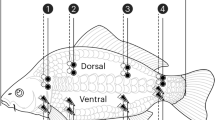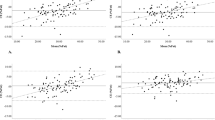Abstract
Objective: To measure body water distribution and to evaluate the accuracy of eight-polar bioelectrical impedance analysis (BIA) for the assessment of total body water (TBW) and extracellular water (ECW) in severe obesity.
Design: Cross-sectional study.
Setting: Obesity clinic.
Subjects: In all, 75 women aged 18–66 y, 25 with body mass index (BMI) between 19.1 and 29.9 kg/m2 (ie not obese), 25 with BMI between 30.0 and 39.9 kg/m2 (ie class I and II obese), and 25 with BMI between 40.0 and 48.2 kg/m2 (ie class III obese).
Methods: TBW and ECW were measured by 2H2O and Br dilution. Body resistance (R) was obtained by summing the resistances of arms, trunk and legs as measured by eight-polar BIA (InBody 3.0, Biospace, Seoul, Korea). The resistance index at a frequency of x kHz (RIx) was calculated as height 2/Rx.
Results: ECW : TBW was similar in women with class III (46±3%, mean±s.d.) and class I–II obesity (45±3%) but higher than in nonobese women (39±3%, P<0.05). In a random subsample of 37 subjects, RI500 explained 82% of TBW variance (P<0.0001) and cross-validation of the obtained algorithm in the remaining 38 subjects gave a percent root mean square error (RMSE%) of 5% and a pure error (PE) of 2.1 l. In the same subjects, RI5 explained 87% of ECW variance (P<0.0001) and cross-validation of the obtained algorithm gave a RMSE% of 8% and a PE of 1.4 l. The contribution of weight and BMI to the prediction of TBW and ECW was nil or negligible on practical grounds.
Conclusions: ECW : TBW is similar in women with class I–II and class III obesity up to BMI values of 48.2 kg/m2. Eight-polar BIA offers accurate estimates of TBW and ECW in women with a wide range of BMI (19.1–48.2 kg/m2) without the need of population-specific formulae.
Sponsorship: Progetti di Ricerca Corrente, Istituto Auxologico Italiano.
This is a preview of subscription content, access via your institution
Access options
Subscribe to this journal
Receive 12 print issues and online access
$259.00 per year
only $21.58 per issue
Buy this article
- Purchase on Springer Link
- Instant access to full article PDF
Prices may be subject to local taxes which are calculated during checkout


Similar content being viewed by others
References
Bedogni G, Bollea MR, Severi S, Trunfio O, Manzieri AM & Battistini N (1997): The prediction of total body water and extracellular water from bioelectric impedance in obese children. Eur. J. Clin. Nutr. 51, 129–133.
Bedogni G, Malavolti M, Severi S, Poli M, Mussi C, Fantuzzi AL & Battistini N (2002): Accuracy of an eight-point tactile-electrode impedance method in the assessment of total body water. Eur. J. Clin. Nutr. 56, 1143–1148.
Bedogni G, Borghi A & Battistini N (2003a): Body water distribution and disease. Acta Diabetol. 40 (Suppl 1), S200–S202.
Bedogni G, Marra M, Bianchi L, Malavolti M, Nicolai E, De Filippo E & Scalfi L (2003b): Comparison of bioelectrical impedance analysis and dual-energy X-ray absorptiometry for the assessment of appendicular body composition in anorexic women. Eur. J. Clin. Nutr. 57, 1068–1072.
Deurenberg P (1996): Limitations of the bioelectrical impedance method for the assessment of body fat in severe obesity. Am. J. Clin. Nutr. 64, 449S–452S.
Deurenberg P, van der Kooy K, Leenen R & Schouten FJ (1989): Body impedance is largely dependent on the intra- and extra-cellular water distribution. Eur. J. Clin. Nutr. 43, 845–853.
Guida B, Trio R, Pecoraro P, Gerardi MC, Laccetti R, Nastasi A & Falconi C (2003): Impedance vector distribution by body mass index and conventional bioelectrical impedance analysis in obese women. Nutr. Metab. Cardiovasc. Dis. 13, 72–79.
Lohman T, Roche A & Martorell R eds. (1988): Anthropometric Standardization Reference Manual. Champaign, IL: Human Kinetics Books.
Lukaski HC & Johnson PE (1985): A simple, inexpensive method of determining total body water using a tracer dose of D2O and infrared absorption of biological fluids. Am. J. Clin. Nutr. 41, 363–370.
Malavolti M, Mussi C, Poli M, Fantuzzi AL, Salvioli G, Battistini N & Bedogni G (2003): Cross-calibration of eight-polar bioelectrical impedance analysis versus dual-energy X-ray absorptiometry for the assessment of total and appendicular body composition in healthy subjects aged 21–82 years. Ann. Hum. Biol. 30, 380–391.
Mazariegos M, Kral JG, Wang J, Waki M, Heymsfield SB, Pierson RN, Thornton JC & Yasumura S (1992): Body composition and surgical treatment of obesity. Effects of weight loss on fluid distribution. Ann. Surg. 216, 69–73.
Raison J, Achimastos A, Asmar R, Simon A & Safar M (1986): Extracellular and interstitial fluid volume in obesity with and without associated systemic hypertension. Am. J. Cardiol. 57, 223–226.
Scalfi L, Bedogni G, Marra M, Di Biase G, Caldara A, Severi S, Contaldo F & Battistini N (1997): The prediction of total body water from bioelectrical impedance in patients with anorexia nervosa. Br. J. Nutr. 78, 357–365.
Steijaert M, Deurenberg P, Van Gaal L & De Leeuw I (1997): The use of multi-frequency impedance to determine total body water and extracellular water in obese and lean female individuals. Int. J. Obes. Relat. Metab. Disord. 21, 930–934.
Van Marken Lichtenbelt WD & Fogelholm M (1999): Increased extracellular water compartment, relative to intracellular water compartment, after weight reduction. J. Appl. Physiol. 87, 294–298.
Waki M, Kral JG, Mazariegos M, Wang J, Pierson RN & Heymsfield SB (1991): Relative expansion of extracellular fluid in obese vs. nonobese women. Am. J. Physiol. 261, E199–E203.
Wang J & Pierson RN (1976): Disparate hydration of adipose and lean tissue requires a new model for body water distribution in man. J. Nutr. 106, 1687–1693.
Wong WW, Sheng HP, Morkeberg JC, Kosanovich JL, Clarke LL & Klein PD (1989): Measurement of extracellular water volume by bromide ion chromatography. Am. J. Clin. Nutr. 50, 1290–1294.
Author information
Authors and Affiliations
Corresponding author
Additional information
Guarantors: A Sartorio and G Bedogni.
Contributors: AS coordinated the study and contributed to the final version of the manuscript; GB analyzed the data and wrote the first draft of the manuscript; MM, OC and NB performed laboratory measurements; FA and PG Marinone performed clinical measurements.
Rights and permissions
About this article
Cite this article
Sartorio, A., Malavolti, M., Agosti, F. et al. Body water distribution in severe obesity and its assessment from eight-polar bioelectrical impedance analysis. Eur J Clin Nutr 59, 155–160 (2005). https://doi.org/10.1038/sj.ejcn.1602049
Received:
Revised:
Accepted:
Published:
Issue Date:
DOI: https://doi.org/10.1038/sj.ejcn.1602049
Keywords
This article is cited by
-
Consistency of the estimated target weights and ECW/TBW using BIA after hemodialysis in patients between standing and lying-down positions
BMC Nephrology (2022)
-
Validation of a multi-frequency bioelectrical impedance analysis device for the assessment of body composition in older adults with type 2 diabetes
Nutrition & Diabetes (2022)
-
Pharmacokinetic Evaluation of Intravenous Vitamin C: A Classic Pharmacokinetic Study
Clinical Pharmacokinetics (2022)
-
Repository Describing the Anatomical, Physiological, and Biological Changes in an Obese Population to Inform Physiologically Based Pharmacokinetic Models
Clinical Pharmacokinetics (2022)
-
Validity of multi-frequency bioelectric impedance methods to measure body composition in obese patients: a systematic review
International Journal of Obesity (2019)



